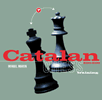CATALAN E00-E09
previewed by Steve Lopez
Two weeks ago we previewed
Sicilian Dragon 2; this week we'll look at another in the "Advanced" series of opening CDs. This one is by Mihail Marin and is called
Catalan E00-E09.
From the author's standpoint, the most difficult thing about an Advanced CD is that it's, well, advanced; it requires a heap of work to produce. You'll recall my comments two columns ago about the amount of work involved in the Dragon CD; the Catalan CD is cast very much in the same mold. In many ways, Marin did even more work, because the Catalan is a pretty slippery opening and hard to pin down. The transpositional possibilities from other openings are quite numerous and it's often hard to discern where one opening ends and the Catalan begins.
Discounting transpositions, there are two basic ways to reach the Catalan:

|
|
1.d4 Nf6 2.c4 e6 3.g3 d5 4.Bg2
|
|
|

|
1.d4 d5 2.c4 e6 3.Nf3 Nf6 4.g3
|
You should be able to spot the common theme: in both positions, White has occupied the center with the d-pawn and has advanced the g-pawn to g3 (with the object of fianchettoing the Kingside Bishop). This hypermodern idea is usually attributed to Savielly Tartakower. However, the basic position can be reached via transposition from other openings, primarily the English. Sometimes it's a real chore just trying to determine whether or not a move sequence qualifies as a "genuine" Catalan.
Marin discusses this problem in the introduction to Catalan E00-E09. One section of the Intro actually made me laugh out loud:
"Judging from my previous experience with the disk dedicated to the English Opening, 1.c4 e5, I embarked the project of the Catalan full of optimism regarding the quantity of work needed. The total number of games was little more than one third of those classified under A20-A29 and my knowledge about these two openings was about similar.
However, when I started working properly I soon understood that this new CD would be not easier to write than the previous one; in fact it would probably even be more difficult."
I hated to laugh but the sad truth is that any writing project always looks easy before you start it -- and electronic chess books on CD might appear easy but are among the hardest things to write. Marin had cause for trepidation: the transpositions make the Catalan a much tougher project than a lot of other openings.
In this case, though, the author has come through with flying colors. There's a staggering amount of information on Catalan E00-E09 and it's amazing (to me, anyway) that Marin managed to finish the CD at all, much less complete the project in under a year.
The CD's main instructional database contains sixty-two explanatory texts; with the exception of the Introduction, each covers a specific variation of the Catalan and (with a very few exceptions) each is several screens long -- in fact, each is equivalent to a chapter in a print chess book. Each text explains the variation in plain language and in great detail; these also provide links to important example games which illustrate the ideas discussed in the texts. Try to imagine a printed chess book containing sixty-one chapters, each of which contains text explanations of variations along with two to three dozen chess games as examples, and you'll have some idea of the amount of information provided on the Catalan CD. As long as you're imagining such a print book, go ahead and imagine a wheelbarrow or a forklift -- you'd need one to be able to transport such a book.
This main database also contains a lot of additional games. The whole shebang has nearly 27,700 games in it, with almost 1600 of these being annotated. It also has an extensive opening key to help guide you through the transpositional twists and turns of the Catalan. (And forget the forklift -- go ahead and imagine a pickup truck).
A second database has forty-six training games; each contains timed training questions which challenge you to find the best move with the clock ticking. After learning the opening from the main instructional database, you use these training games in the second database to test your knowledge of the Catalan.
The CD also contains an extensive Catalan opening tree of over 400,000 unique positions. You can use the tree for statistical research, looking at the statistical success (or lack thereof) in practical play for any move in the tree. You can use the tree as a sort of index to guide you through the myriad variations (and which will always catch transpositions). And you can load the tree into any of the Fritz family of playing programs as an opening book, thereby forcing the program to play nothing but the Catalan. (Skip the pickup truck -- let's jump on up to an eighteen-wheeler).
Finally the CD contains a copy of ChessBase Reader, so that anyone who doesn't already own a copy of either ChessBase or Fritz can access the wealth of material on the disk.
A word of warning is in order here: this CD definitely earns the title of "Advanced". Catalan E00-E09 isn't for the timid -- the amount of information provided is absolutely staggering, the instruction is written with higher-level club players and titled players in mind, and the labyrinthine nature of the Catalan's transpositional possibilities makes this a daunting opening to learn in any case. But if you're willing to take up the challenge, Catalan E00-E09 won't disappoint you at all -- it's easily one of the most informative instructional CDs that ChessBase has yet produced.
Until next week, have fun!
© 2004, Steven A. Lopez. All rights
reserved.

























